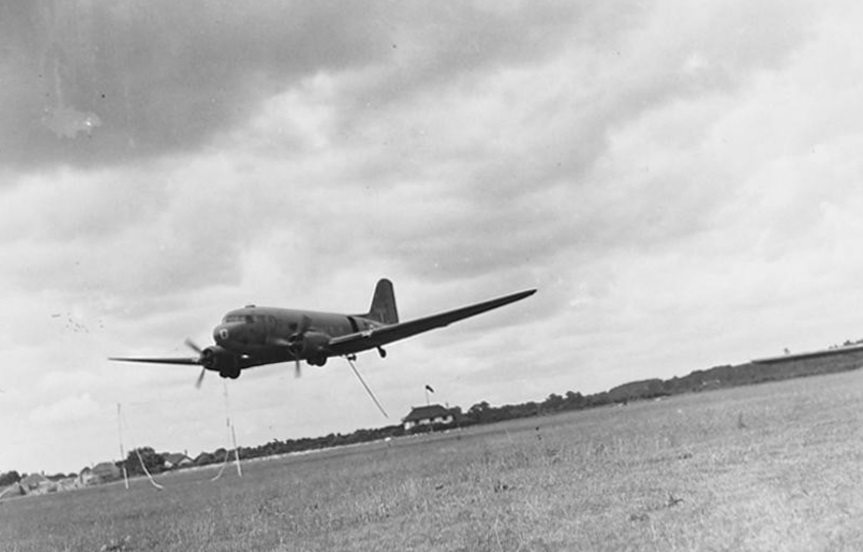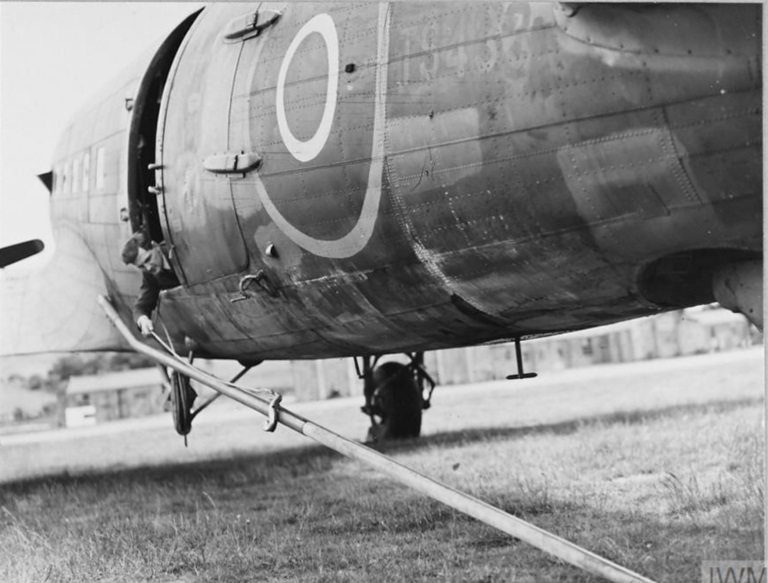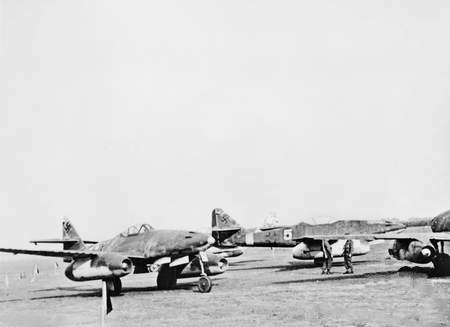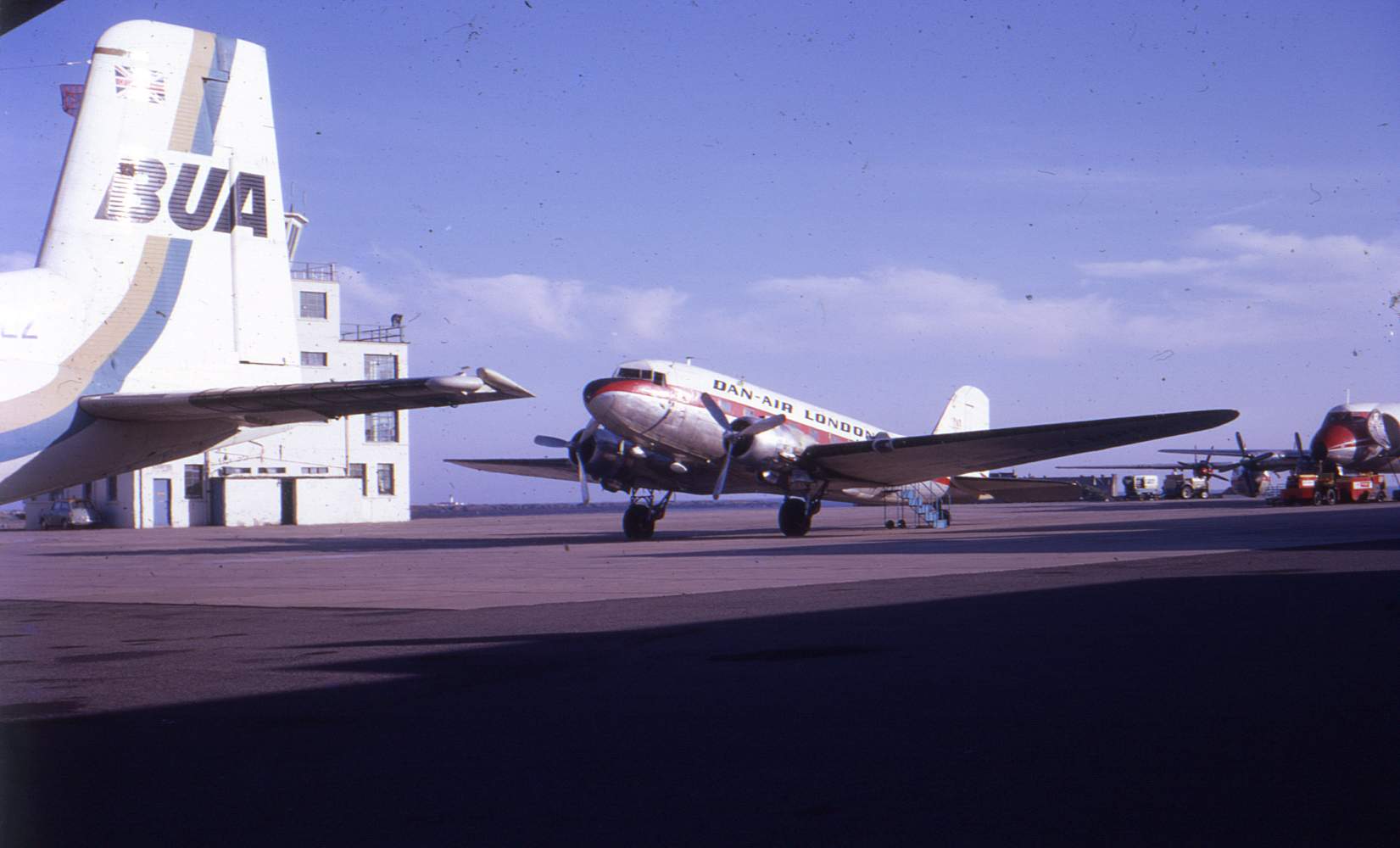June 1945
The end of the war in Europe brought immediate changes to many of the USAAF Troop Carrier Groups. With no airborne operations ongoing, many were rapidly packed-up and despatched homewards across the Atlantic leaving the day-to-day air transport requirements of the US Forces in Europe in the hands of their Air Transport Command and Air Service Command. The RAF, however, had no separate Troop Carrier Command and Transport Command’s functions simply altered to accommodate the increasing percentage of operations which were freight and passenger transport. But there was also a war to finish in the Far East and glider towing, container dropping and formation flying remained on 46 Group’s To-Do list. Pilot Officer Stableford’s crew was with 107 Operational Training Unit (OTU ) at Leicester from February until early April 1945 practising all the airborne arts plus 3 hours and 40 minutes of ‘SEAC Supply Dropping’ (1) thrown in during March as a portent of the future. A number of glider-snatching exercises were also flown from Leicester using Dakotas TS424, TS433 and TS434 to practice the tricky manoeuvre.
(1) South East Asia Command had been created in August 1943 to combine US, British, Australian and New Zealand forces in the war against Japan. Its sphere of influence ran from India and Ceylon through Burma and Malaya to northern Indonesia. Lord Louis Mountbatten was the Supreme Allied Commander from October 1943 and, from February 1945, air operations were controlled by the legendary New Zealander Air Marshall Keith Park.


Many changes were on the way, involving the rationalisation of the huge number of wartime airfields, changes in squadron roles and mass movements of aircraft and personnel between squadrons. For 233, this initially entailed the move of the Squadron from its long-established base at Blakehill Farm to the Hampshire airfield of Odiham. The June volume of the Squadron’s Operations Record Book Summary of Events records that this was accomplished with ‘much confusion to all, in view of the anticipated move to St.Mawgan for an even farther move to SEAC – a Command which many personnel of this unit already know far too well!’. While the move to St.Mawgan never occurred, and would have been strange given the Squadron commitments for the rest of the summer, the planned transfer to Asia remained imminent and ten air crews were exchanged between 233 and 575 squadrons in the second half of June.
By June 1945, a large part of 46 Group’s strength had already either transferred to European airfields or sent detachments to the continent. The two Broadwell-based squadrons had moved to Brussels-Evere: 512 moved to B56 at the end of March 1945 and 575 sent 20 aircraft to join them at Evere on May 27th. Fellow Blakehill Farm residents, 437 Squadron RCAF, had sent detachments alongside 233’s unit to B75/ Nivelles prior to Operation Varsity. 437 sent a further detachment to Nivelles on May 7th and the Canadian Squadron eventually moved to Melsbroek. 233, however, continued to operate from Blakehill until switching to Odiham in mid-June.
On June 1st, FZ681 lifted from Blakehill at 08:45 en route to Croydon to collect passengers for B56/ Brussels Evere. KG585 was also on a regular mission, transporting freight to Copenhagen, travelling to B156/ Luneburg in ballast, before uplifting 30 ex-POWs for the journey to B56/ Brussels. In fact, at least 13 Dakotas were sent to Copenhagen (the Summary of Events says 18) via differing intermediate airfields. They returned to Saltby carrying airborne forces. Typhoon squadrons on the continent were also on the move and, on June 3rd, fourteen 233 Squadron Dakotas transported 266 Squadron personnel from Fairwood Common to B111/ Ahlhorn before returning to Fairwood Common via B109/ Quakenbruck with 222 Squadron airmen. FZ681 was busy on fuel transport flights to B162/ Stade. The following day saw a further 10 aircraft ferrying freight and passengers to and from Fairwood Common.
Further flights to Norway continued with six aircraft staging to Oslo from Boreham and, variously, via B156/ Luneburg and B118/ Celle. KK141, a Dakota Mk IV, was delivered from an initial allocation to 238 Squadron and joined FZ665 on a flight to Oslo. The two aircraft departed from Croydon and Boreham respectively, with FZ665 carrying 5000 lbs of freight and taking 4 hours and 25 minutes to reach the Norwegian capital.While six managed to return the same day, a further five aircraft flew to Oslo then night-stopped at B156/ Luneburg or Copenhagen on the return. Two aircraft had left Blakehill Farm on September 3rd and flown to Edinburgh Turnhouse to collect the RAF Regiment band. They were flown to Oslo before the Dakotas returned via Copenhagen and Luneburg (KG415). On June 6th 1945, KG561 departed Northolt en route to Guernsey ready to act as the Met aircraft for George VI’s VIP flight departing the Channel Islands the following day. Lifting-off at 17:40, KG561 was flown from Guernsey back to Northolt arriving at 18:45 having, presumably, recorded weather conditions along the route. The crew then flew on to 233’s projected new base at Odiham.
June 7th would be 233 Squadron’s last full day at Blakehill Farm. There were varied operations: passenger flights from Gatwick to B77/ Gilze, freight to B89/ Mill, casualties back to Down Ampney and Blackbushe, ex-POWs to Dunsfold and Hendon and repatriated civilians from R62/ Mengen and B78/ Eindhoven to Northolt. KG585 began to move kit and personnel from Blakehill Farm to Odiham. Aircraft taking-off the following day, June 8th, would return to Odiham. Thirteen Dakotas left on operations to other airfields including KG448 flown by Barry Stableford’s crew to Luton and then on to Oslo and B156/ Luneburg. KG400 and FZ688 were also routed to Oslo but via Boreham. KG675 and FZ678 lifted Derwent jet engines to B158/ Lubeck, presumably for 616 Squadron. KG341 and KG415 flew to Oslo via Banff in Scotland. Banff had been the home of Beaufighter and Mosquito squadrons charged with assisting allied operations in Norway and the station complement included a Royal Norwegian Air Force squadron. A contingent of fifteen Dakotas was assigned to shuttling personnel and equipment between Blakehill and Odiham. KG441 was employed on the round trips and FZ681 was one of several aircraft making three return flights.

Operations from Odiham continued in much the same vein with between eight and fourteen aircraft on continental passenger and cargo operations each day. Destinations expanded slightly although Oslo remained a regular run accounting for four aircraft on 10th/ 11th June, eight on 13th/ 14th and three on 17th/ 18th June. B58/ Melsbroek, B156/ Luneburg and Marseilles Istres were still frequent calls and flights to B116/ Wunsdorf increased along with visits to the US airstrips Y74/ Frankfurt and Y80/ Wiesbaden. Other new destinations included R57/ Wesermunde, B116/ Hannover, B113/ Varrelbusch, Y89/ Mannheim along with Ghent, Rennes, Le Bourget and Pilsen. Personnel flights were often routed via Blackbushe (sometimes called Hartford Bridge in the 1940s) and returned via Hendon, Croydon, Northolt, Dunsfold and Ford. Many cargo flights originated from Greenham Common, Boreham and Stoney Cross. Passengers transported included SHAEF staff, SEAC personnel, RNVR officers, Dutch Navy crew, Belgian and Russian ex-POWs, RAF Staff College airmen, the WAAF band and Russian Displaced Persons (2). FZ681, back in the hands of Flt. Lt. Priestley, carried boiler tubes from Greenham Common to Melsbroek on June 16th, KG420 flew a jeep and trailer to Oslo on June 18th, KG403 carried a shipment of currency with a security escort from Croydon to the continent on June 23rd. KG441 was away to Oslo on June 27th with a Merlin aero engine and RAF personnel while KG403 airlifted passengers from Croydon to R14/ Detmold and then Displaced Persons to B156/ Luneburg and B56/Evere. On June 28th, five Dakotas flew from Odiham to Ibsley to collect passengers for transport to Oslo and Trondheim. Over-nighting in Norway, the aircraft then flew on to Bardufoss in Northern Norway before returning to Oslo. Three aircraft then returned to Odiham while KN258 and KG437 transported 39 displaced French sex workers back to Paris. The ladies had been forcibly taken to Norway to cater for the German garrison. The end of June saw the transfer of personnel between 233 Squadron and 575 Squadron prior to the following month’s despatch of 233 Squadron to SEAC duties in India. The crew were transferred between Odiham and Broadwell on June 29th and an operation to Norway the following day brought flying for June 1945 to a close with 436 sorties completed to the continent totaling almost 3200 flying hours.
(2) Initials: SEAC = South East Asia Command, SHAEF = Supreme Headquarters Allied Expeditionary Force, RNVR= Royal Navy Volunteer Reserves, WAAF= Womens Auxiliary Air Force, POWs= Prisoners of War.

233 Squadron and the Fedden Mission of Summer 1945:
Although much of the Squadron’s work in June 1945 was routine, two Dakotas were seconded to a military project which was of vital importance to Britain. A technical mission was despatched to Germany to investigate and commandeer military and communications technology and also attempt to recruit leading German scientists and obtain secret weapons documentation. Unfortunately, the US and Russian forces proved to be way ahead of the British and the UK’s failure to capitalise on, particularly, rocket and jet engine discoveries in the occupied zone hindered their scientific progress for the next couple of decades. Stafford Cripps, the British wartime Minister for Aircraft Production, recruited Sir Roy Fedden to lead the fact-finding mission. Sir Roy had spent a distinguished career at the Bristol Aircraft Company and was responsible for many of their most successful engines. He had also led an earlier fact-finding mission to ascertain the abilities of the US aircraft industry in 1942-43. His team for Germany included a Professor of Aeronautics and two members of the Royal Aircraft Establishment. They were allocated two of 233 Squadron’s Dakotas, FZ678 and KG713, flown by Flt. Lt. Reid and Flt. Lt. Cheany respectively. The two aircraft departed Odiham just after midday on June 12th for the short hop to Northolt. Each aircraft embarked four VIPs and one jeep, KG713 also carrying one ground crew member. After a short delay owing to poor weather, the Dakotas took off at 14:05 and 14:40 en route to B151/ Buckeburg in Lower Saxony, 25 miles west of Hannover. They arrived in a heavy rainstorm and, with no hardstanding available for the Dakotas, they flew on to B116/ Wunsdorf, arriving at 17:00. After unloading the jeeps, the party drove back to their original intended destination, the Second Tactical Air Force HQ at Bad Eilsen before adjourning to the 2nd Army group HQ at Bad Oeynhausen.
The following day, Wednesday June 13th, Sir Roy’s party motored to Volkenrode, 20 miles to the east of Hannover where the Hermann Goering Institute had maintained six sophisticated wind tunnels for the testing of the ME 262 jet fighter. The research centre had also worked on materials testing, turbine blade design, ballistics evaluation and the V-1 pulse jet. The facility had escaped bombing raids and the jeep-borne party discovered that the nearby town of Braunschweig also had a functioning airfield despite extensive damage to the residential area. The Advanced Landing Ground R35/ Braunschweig had been occupied by US Forces as long ago as April 13th and, by the time Fedden arrived, the American military had settled-in at the Volkenrode Research Centre even though it was nominally in the British Sector. Fedden’s team were especially interested in research on swept wing design and briefly managed to get an airflow model working in one of the wind tunnels. The next morning, the British discovered that the swept wing model had gone, misappropriated by an American engineer assigned to Boeing’s RB-47 design team (3).
(3) From the book ‘The Race for Hitler’s X-Planes. Also quoted is Wolfgang E.Samuel from his book ‘American Raiders’ who cited an American scientist: ‘The trick was to get whatever test equipment out of the place without the British noticing. As soon as everyone was in bed and the lights were out, we’d spring into action’ delivering the booty to Braunschweig where a B-17 and a B-24 were eagerly waiting.
The two Dakotas were flown-up from Wunsdorf on June 15th, arriving in the early afternoon. The party was ready to move on to the next site and both aircraft departed that evening for the forty minute flight to Y96/ Kassel Waldau. Sir Roy’s group was to stay at the American Intelligence Center at Camp Dantine, around 12 miles from Kassel. It was found that the airfield R13/ Hessich-Lichtenau was closer to the camp, so the two Dakotas were flown there on June 16th following visits to R15/ Oschersleben by FZ678 and Gottingen by KG713 (4). The first couple of days had underlined that travel by road was going to be arduous owing to a lack of signposting, damaged surfaces and huge numbers of displaced persons. In future, the Dakotas would be used to get as close to ‘target’ sites as possible before the jeeps were unloaded for local travel. from Camp Dantine, the British scientists split into two groups in order to visit both the Junkers factory at Magdeburg and research facilities at Gottingen.
FZ678 departed Germany on the morning of June 17th with a 2 ton load of plundered test equipment destined for Northolt. The return flight to Hessich-Lichtenau was made the following day arriving at 16:20. KG713, meanwhile, had departed that morning for R35/ Volkenrode prior to flying on to R32/ Kothen which was close to the Junkers plant at Dessau. The team flew back to R13/ Hessich the same night, finding airborne travel much more efficient than using the jeep. However, a second group probably did use one of the jeeps on June 18th to motor the 35 miles south-east from Hessich to the BMW works at Eisenach. They found a camouflaged factory sunk into the side of a hill and a second factory in the town itself. While the latter had produced motorcycles and engine components, the hidden factory had initially focused on piston engines. BMW 003 jet engines were produced latterly by a work force of eleven thousand, with 6500 in the town works at Eisenach. Members of Fedden’s team visited BMW’s Stassfurt factory on the following day where they found the manufacturing plant for BMW 003 jet engines 400 metres below ground in an old salt mine. Unfortunately for them, the workforce had destroyed much of the technology and looted other useful equipment proving their dedication to the Nazi cause.
On June 19th KG713 flew from R13 to R15/ Oschersleben, near Magdeburg, to deliver part of Fedden’s team to the nearby Junkers factory while FZ678 flew directly to R19/ Nordhausen. As with the two BMW plants, Magdeburg was inside the area demarcated for Russian occupation, so both US and British forces urgently needed to visit the Junkers factory to evaluate the Jumo 004 jet engine testing and production facilities. Junkers Production Director Otto Hartkopf explained that most of the drawings relating to jet production had already been removed by the allies and the extensively bomb-damaged factory proved less interesting than anticipated. Most of the discussions with Junkers engineers centred on the Jumo super-charged piston engine production.
The same afternoon, June 19th, KG713 flew on from R15 to R19/ Nordhausen, a location in the Harz Mountains which brought the team into contact with the forced labour system. They were joined there by members of Sir Roy’s group who had motored down from the BMW factory at Stassfurt on a hot, sunny June afternoon. By contrast, the plant at Nordhausen was a grim reflection of the evils of the Nazi system. The mission had been told to expect a ruthlessly-efficient subterranean manufacturing plant at Kohnstein, outside Nordhausen. The Mittelwerk plant was, unbeknown to Fedden’s group, linked to concentration camps, such as Buchenwald, whose prisoners had been used to dig the tunnels and, subsequently, assemble V-1 flying bomb and V-2 rockets. Two parallel, mile-long tunnels, about 160m apart, had been excavated from one side of the Kohnstein mountain to the other and interconnected via 46 transverse galleries where production and checking took place. Once opened, the slave labour was housed in a new concentration camp, Mittelbau Dora, constructed close to one of the primary tunnel entrances. There were also 40 or so subsidiary camps scattered around the area.
(4) 233 Squadron’s Operations Record book has KG713 flying directly to R13 on June 16th.
Fedden’s team arrived shortly before the complex was due to be handed over to the Russians and they were only able to inspect a limited area of the vast plant. They discovered wingless V1s and stores of V2 components. The Americans had largely departed the plant but, having been in occupation since April 11th, had taken the opportunity to remove huge stores of equipment – some said as many as 300 full railway wagons. There remained much modern, large-scale production equipment but it had been hurriedly wrecked or abandoned along with the tooling and instruments necessary to construct V2s. the British team also visited the Dora Concentration Camp and saw the horror of a factory system which had seen up to 250 deaths per day when it was in action. It has been estimated that the 4575 V2s built cost far more lives in their construction than they ever took when deployed against the allies. Of 60,000 prisoners consigned to Mittelbau Dora, up to 25,000 died in appalling circumstances. Sadly, as many as 1500 prisoner deaths might be attributable to an RAF bombing raid in early April 1945 which mistook the concentration camp for army barracks.
KG713 and FZ678 both returned to R13/ Hessich Lichtenau on the evening of June 19th. The next morning, June 20th, KG713 flew directly to R74/ Oberwiesenfeld, close to Munich, while FZ678 routed there via R19/ Nordhausen. While billeted at the US Third Army’s Intelligence Centre at Friesing, members of Fedden’s team made several visits to the BMW works in Munich to visit Sir Roy’s old friend, Dr Bruckmann. Meanwhile, KG713 was flown down to Frankfurt on the afternoon of 21st in order to refuel before transferring to the SHAEF airfield Y73 at Frankfurt Rhein Main. The Dakota was airborne again at 18:10 heading for R15/ Oschersleben once again. Their task was to pick-up a BMW engine; however, it couldn’t be found and the aircraft returned to R74/ Munich the following morning. FZ678, meanwhile, had flown to R62/ Mengen so that the liason officer could drive up to Lindau to obtain passes for visiting the Stuttgart area the following day.
June 22nd saw one group driving south from Munich to the Messerschmidt Experimental Department at Oberammergau where the plan was to investigate the Jet Engine Installation. When they arrived there, they found that a group from Bell Aircraft had been in residence for some weeks following US liberation of the plant on 29th April. Interestingly, Sir Roy’s group had also been pre-empted by the DeHavilland Aircraft Company who also had an engineer in residence. FZ678 had flown back to Munich early on the morning of June 22nd to collect the team due to visit Stuttgart. With permits in place, FZ678 flew to R50/ Stuttgart enabling the scientific team to visit the Bosch works. The aircraft returned to R74 that night with the entire party staying at Freising that night.
KG713 returned to Y73/ Frankfurt Rhein Main on 23rd June with two of the mission VIPs. Sir Roy remained at the SHAEF Headquarters and, after a couple of short hops between local airfields, the Dakota returned to R74/ Oberwiesenfeld with two VIPs. FZ678 headed back to Stuttgart again, unloaded the jeep and waited while a visit was made to Esslingen and Reuthlingen. The Dakota returned to R74 that night.
KG713 lifted from R74 at 08:20 on June 24th en route to Frankfurt to collect Sir Roy. The taxied him back to Munich and, the same evening, the party transferred from R74/ Obwiesenfeld to Y75/ Frankfurt Robstock. The same afternoon FZ678 flew the Munich personnel down to Salzburg – possibly for permitting as Flt.Lt Reid’s crew was on the ground for only a short time before returning to Munich.
The next morning, Flt. Lt. Cheaney’s crew flew KG713 up to R35/ Volkenrade to collect a BMW jet engine. The cargo was loaded during the evening and the Dakota took off at 07:50 on June 26th bound for Northolt with two VIP passengers and the engine. They continued to the Odiham base with the two passengers, arriving at 14:25. It was only a short maintenance stay and they took-off the next morning on the return leg to Frankfurt. This time they embarked the entire scientific party plus a jeep and returned to Northolt on June 28th at the end of that part of the mission.
In the meantime, FZ678 had shuttled from Munich to Frankfurt and, on June 26th, embarked a jeep and 4 passengers for the return flight to Northolt via B56/ Brussels Evere. The Dakota positioned to Odiham that evening and the crew appear to have had a break until Saturday June 30th when they returned to Munich, via Stuttgart, carrying a jeep in Dakota KN443. Having picked-up Mr Stern and Flt. Lt. Beeton plus Mr Bruckmann of BMW, they proceeded to Salzburg on July 1st. The weather was distinctly poor for the summer and, with conditions not permitting flying, the party proceeded from Salzburg to Spittal and on to Klagenfurt by road. The aircraft flew on to Klagenfurt on July 3rd and collected the jeep and two passengers before continuing to Munich the following day. The engineers had traveled to Munich to arrange for the use of BMW’s high altitude aero engine test bed later in the month. KN443 then returned to Northolt, arriving at 17:30 on July 4th. Both 443 and KG713 returned to operational flights to Germany on July 5th with Flying Officer Diamond taking KN443 to Y74/ Frankfurt with army stores. KG713 returned to Odiham on July 5th via Frankfurt having visited B153/ Bad Oeyunhausen (5) and B116/ Wunsdorf. FZ678 returned to Germany on 8th July with a flight from Odiham to Gatwick continuing to R14/ Detmold with SHAEF freight. The return to Odiham via B160/ Copenhagen (6) was followed by a detachment to ‘C’ flight from the next day until July 12th and the start of preparation for her flight to India.
Sir Roy Fedden’s mission did make some further trips to Europe but, ultimately, the equipment he brought back to Britain and the information he attempted to gather was largely ignored by the establishment in the UK (5). His group had also obtained a VW Beetle rolling chassis from Major Ivan Hurst, the REME officer charged with resuscitating the Volkswagen factory at Wolfsburg. During 1946, Fedden developed his own rear engined F-car but it proved unstable. His company, Roy Fedden Ltd, expanded to employ around 200 personnel working on the car and flat-6 low drag aero engines during 1946/ 47 but, by May ’47, little commercial interest had been generated and the company went into liquidation.
(5) It has been said of Sir Roy’s mission that the British captured a few aero engines and a VW Beetle chassis while the USA secured 2000 tons of high technology. However, there were other British groups in action including the joint US/ British T-Force which was established to secure Nazi war technology ahead of the Red Army. Brigadier Ted Grylls (Bear Grylls’ grandfather) led the group from their HQ at B153/ Bad Oeynhausen. Air Technical Intelligence teams located captured aircraft within Germany and diverted them to 409 Repair & Salvage Group located at B164/ Schleswig air base. The captured craft were made as airworthy as possible prior to ferrying to Farnborough by pilots such as the Royal Navy’s Captain Eric ‘Winkel’ Brown. The advanced air strips at Twente, Melsbroek and Gilze-Rijen were used as intermediate stops and, by early 1946, some 75 aircraft had been flown to the UK and 50 more transported by sea.
(6) Thanks to Wikipedia’s authorative article on Advanced Landing Grounds.
As for the main Squadron, between ten and fifteen of 233’s Dakotas were deployed on transport missions to the Continent on most days during the first two weeks of July 1945. KG441 and KG341 were detached to 167 Squadron at Blackbushe while their Vickers Warwicks had technical difficulties ironed-out. Regular destinations in Europe continued to be B160/ Copenhagen, B168/ Hamburg, B164/ Schleswigland, B61/ Sint Denis, B116/ Wunstorf, R14/ Detmold, Y56/ Monchen-Gladbach, Pilsen, Berlin and B156/ Luneberg. Some flights were also undertaken between the USAAF bases at Burtonwood, Langford Lodge, Y80/ Wiesbaden and Y74/ Frankfurt. KG635 delivered 4000 musical instruments to Gatow on July 12th, KG415 hauled a load of typewriters and KN565 carried the Marines Band from Hamburg to Berlin.
Other aircraft took part in glider towing exercises and supply dropping practice on July 16th between Odiham and Broadwell. Similar training took place on 17th along with local formation flying. Low level formation flying and paratrooper dropping exercises followed on 19th and 20th of July, glider towing on 22nd. The training was geared to forthcoming South East Asia Command (SEAC) operations against the, as then, undefeated Japanese. In preparation for the long flight to India, navigators were dispatched to Pocklington for LORAN training in Halifaxes on 18th and 19th July.
233 Squadron was not the only 46 Group Squadron on the move at the end of WW2. Their Down Ampney neighbours from Blakehill Farm days, 48 Squadron, were also en route to India in summer 1945 while 271 Squadron moved to Odiham following 233’s departure. 512 Squadron had been detached to Brussels Evere in Spring 1945 and now returned to Holme-on-Spalding Moor in Yorkshire in July 1945. Their previous fellow Broadwell residents, 575 Squadron, moved to RAF Melbourne, also in Yorkshire, before returning to the Cotswolds at Blakehill Farm in autumn 1945. Moving westwards were the two Royal Canadian Air Force squadrons founded in India: 435 and 436 Squadrons. They arrived at Blakehill in August 1945 while their fellow Canadians, 437 Squadron, who had been at Brussels with a detachment in Norway, moved to Odiham to join 271 Squadron.
Not all personnel or aircraft moved with their respective squadrons. 233 and 575 Squadrons exchanged quite a large number of personnel and only twenty 233 Sqdn Dakotas made the flight to India. Indeed, even the Dakotas flown to Imphal didn’t remain in India, they were transferred to the two Canadian squadrons traveling to the UK, 435 and 436 Squadrons and traveled west with the Canadian personnel. Of the Dakotas which didn’t travel to India, many ended up with 1336 Transport Conversion unit. this entity had been established on 30th June 1945 at RAF Welford following the departure of USAAF C-47s of 315 TCG and 435 TCG to advanced landing grounds on the Continent. With the end of the war, several Bomber Command squadrons were switched to Transport Command and equipped with Dakotas. The crews needed conversion training and a series of Transport Conversion Units were set-up. A few Dakotas were recorded as going to a specific ex-Bomber squadron (7) prior to transfer to newly-opened TCUs. Many of these ex-233 Squadron Dakotas were civilianised during 1946 after brief stays at 22 Maintenance Unit in Carlisle. Scottish Aviation were major players in the demobbing of Dakotas, but Canadair also bought some ex-233 aircraft.
(7) Air Britain’s ‘DC-3 and its Predecessors’ notes that 10 Squadron RAF moved from Bomber to Transport Commands in May 1945 and took-up a short residence at Broadwell in August 1945. In the interim, 1336 TCU was set-up at Welford on 30th June 1945 and FZ681 is credited to 10 Sqdn/ 1336 TCU as from 19th August 1945. Similarly, KG351 was recorded as moving from 233 Squadron to 10 Squadron in May 1945 and, upon creation of 1336 TCU, it moved to Welford on 16th August 1945. Two other 233 Dakotas, KG447 and KG561, also moved to 10 Squadron before being switched to 1336 TCU on 16th August. 10 Squadron subsequently moved to India with its own batch of Dakotas in October 1945.
Similarly, 76 Squadron transferred from Bomber Command to Transport Command at Broadwell and was equipped with Dakotas on 8th May 1945. FZ686, FZ688 and KG410 are recorded as being received from 233 Squadron briefly before being moved on to 1336 TCU on August 16th, possibly for use by 76 Squadron pilots at Welford. 76 Squadron also moved to India shortly afterwards in September 1945. 78 Squadron followed a similar pattern, nominally receiving 233 Squadron Dakotas KG398 and KG585 before they were assigned to 1336 TCU on August 19th and 23rd respectively.
Hits: 280

